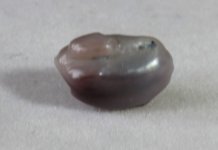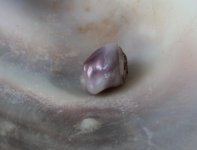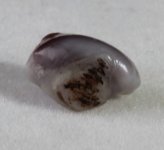Lagoon Island Pearls
Well-known member
- Joined
- Dec 8, 2009
- Messages
- 2,143
In recent times I've seen this video posted online,
Before commenting, I will disclaim a few things. The video was produced by the SSEF lab and contains beautiful scene work by our friend and pearl farmer Josh Humbert. (and others, if I'm remiss). This review is not intended to take away from the fine work of these industry professionals, but to provide some clarity to a new myth that seems to be generated within the last decade.
Let us start with some background to this concern. For nearly a century, it was put into the public domain that somehow pearls are typically formed by grains of sand. For what reason? The myth seems to be perpetuated from a statement of policy issued by the Mikimoto company nearly a century ago. There it was purported that any foreign object, including a grain of sand may give rise to the onset of natural pearls.
Decades of pearl farming around the world have shown us that nowhere in the aquacultural history of the industry do farmers or their technicians use grains of sand in the process.
Several years ago, our highly respected admin and pearl farmer Douglas posted a video demonstration. I say demonstration, not controlled experiment. As valuable as this presentation is, it's not objective. In that video, our father of pearl manually placed several teaspoons of sand into the visceral cavity of a P. sterna oyster. It was observed over a period of time as the mollusk gathered and expelled for the most part, all of the sand.
Since that video was published, a new myth arose, That pearl onset by sand is a myth. For example (name excluded):
Let us expand on this by looking at the timeline of the reviewed video.
00:30 - "Natural pearls are rare and accidental formations in wild oysters."
True, but claimed among a narrowly described group... oysters. This is a cultural statement, not a natural one. In nature, pearls are not limited to any single taxonomy. Broadly, cultural shell stock are not Order Ostreidae, nor are they exclusive of other mollusks. Even in China, although shell stock is commonly referred to as oysters, they are true mussels.
00:35 - "As such, their formation is a hard phenomenon to study"
I disagree, vehemently. It's not difficult at all. I've been studying micro-pearls for decades. The one thing I enjoy which most pearl farmers do not, is I can produce natural pearls on demand. Not just pearls either, but changes in "pre-pearl" epithelial behavior. ( I will touch on this again later).
00:51 - "In an oyster, there are specific cells that have one sole role in life, that is to produce mother of pearl. (bolding mine)
Again, I disagree. Epithelial cells are not at all simplistic as suggested. They are highly modifiable. While it's true, each mineral producing cell spends a great deal of it's life producing nacre, these cells may be modified to other duties. Not only can they lay up aragonitic and proteins to build shell, they can also "revert", by producing acids and reclaiming metabolic calcium from shells during times of environmental stress (burial, low salinity etc.) or during quiescence. This is why pearl farmers harvest mainly during winter months, when calcite percentages are at a minimum.
01:03 - "A natural pearl is thought to form by a mantle injury, that may lead to a displacerment of cells."
True, but again an issue of exclusivity. On the pearl farm, grafting can be deemed as epithelial displacement. 100% of all cultural pearls, whether marine or fresh water origins are the result of this, however in nature the incidence is actually quite low. The greater part of natural pearl formation is epithelial modification, not displacement. Though not mentioned in the video, "irritation" is an irritating word. Mollusks do not necessarily get friction rashes, because they do not posses the musculature or dexterity for self-inflicted injury. The correct term is "perforation", where cells are split from each other, but still possess a neurological and vascular connection with each other, hence "bridging" occurs. Mantle tissues are combined to a highly tactile form.and will always endeavor in their creation to form an immediate contact with the shells.
01:11 - "Most pearls form in mantle of the oyster"
While the original SSEF course suggested "all natural pearls are formed in the mantle" was edited to affirm "most natural pearls", I disagree.
Again, if we view this through the eyes of a pearl farmer, it may seem true, but it's not. In mussels, the mantle shares the same space as it's gonads. Not so much as a single organ, but a series of gonoducts which infiltrate the mantle tissues. At a microscopic level, cells are modified by autoimmune disorder, blood borne parasites or muscular hyper extension. Again, several formations in complete absence of displacement.
Natural pearls are not exclusive to the mantle. They also commonly form in the pericardium, extrapallial space, byssal gland, visceral mass, adductor muscles. In fact, if it has a vascular supply and mineralizing e-cells are present, chances are a pearl may form there. Again, these are observations of the cultural realm, not necessarily that of a natural one.
One thing that was completely omitted from this video is the distinction between homogeneic grafting and xenogeneic displacement. In other words, parasites and/or foreign mantle tissue introduced into other species. These create an entire other group of natural pearls. Parasites capable of drilling create external > internal blister pearls. Parasites or foreign objects and yes... the proverbial grain of sand may enter the extrapallial space and be "spray painted" to the shell. Blood borne protozoa may give rise to spontaneous pearl formation, in either mono, poly or anti nuclear ways. Dead parasites may fester whilst trapped in tissues. Either by host epithelial perforation or rarely by actually putting the mantle of the dead creature on "life support" within the vascular system of the host.
01:43 - "After studying hundreds of thousands of pearls, we have never found a grain a sand inside an actual pearl."
This one gets a "WOW!" from me. While this may be the case with SSEF methodology (or it's shortfalls), it certainly is not with my work. I have observed hundreds, if not thousands of grains of sand at the nuclei of natural pearls in multiple species. It is immediately apparent and indeed a direct cause of natural pearl formation, albeit the incidence is low when compared to other onsets.
In conclusion. We need to look at the bigger picture, not just solely through the eye of the pearl farm industry or the labs which revolve around it. In industry we are limited by species and overshadowed by paths of artificial means to an economic end. While some are, most natural pearls have little or no monetary value, but are outstanding examples of the diversity of nature, fingerprints on the health of our oceans whether by acidification, climate change or environmental stress. New medicines and physical health treatments stem from shellfish science.
As a group of experts, we must be mindful of the tenets of science and espouse them objectively and correctly.
I welcome your comments.
Before commenting, I will disclaim a few things. The video was produced by the SSEF lab and contains beautiful scene work by our friend and pearl farmer Josh Humbert. (and others, if I'm remiss). This review is not intended to take away from the fine work of these industry professionals, but to provide some clarity to a new myth that seems to be generated within the last decade.
Let us start with some background to this concern. For nearly a century, it was put into the public domain that somehow pearls are typically formed by grains of sand. For what reason? The myth seems to be perpetuated from a statement of policy issued by the Mikimoto company nearly a century ago. There it was purported that any foreign object, including a grain of sand may give rise to the onset of natural pearls.
Decades of pearl farming around the world have shown us that nowhere in the aquacultural history of the industry do farmers or their technicians use grains of sand in the process.
Several years ago, our highly respected admin and pearl farmer Douglas posted a video demonstration. I say demonstration, not controlled experiment. As valuable as this presentation is, it's not objective. In that video, our father of pearl manually placed several teaspoons of sand into the visceral cavity of a P. sterna oyster. It was observed over a period of time as the mollusk gathered and expelled for the most part, all of the sand.
Since that video was published, a new myth arose, That pearl onset by sand is a myth. For example (name excluded):
Sad to say, you are perpetrating the myth, yes I said MYTH, that a grain of sand can ever cause a pearl to form. Find out the TRUTH on the Pearl-Guide.com forum!
Let us expand on this by looking at the timeline of the reviewed video.
00:30 - "Natural pearls are rare and accidental formations in wild oysters."
True, but claimed among a narrowly described group... oysters. This is a cultural statement, not a natural one. In nature, pearls are not limited to any single taxonomy. Broadly, cultural shell stock are not Order Ostreidae, nor are they exclusive of other mollusks. Even in China, although shell stock is commonly referred to as oysters, they are true mussels.
00:35 - "As such, their formation is a hard phenomenon to study"
I disagree, vehemently. It's not difficult at all. I've been studying micro-pearls for decades. The one thing I enjoy which most pearl farmers do not, is I can produce natural pearls on demand. Not just pearls either, but changes in "pre-pearl" epithelial behavior. ( I will touch on this again later).
00:51 - "In an oyster, there are specific cells that have one sole role in life, that is to produce mother of pearl. (bolding mine)
Again, I disagree. Epithelial cells are not at all simplistic as suggested. They are highly modifiable. While it's true, each mineral producing cell spends a great deal of it's life producing nacre, these cells may be modified to other duties. Not only can they lay up aragonitic and proteins to build shell, they can also "revert", by producing acids and reclaiming metabolic calcium from shells during times of environmental stress (burial, low salinity etc.) or during quiescence. This is why pearl farmers harvest mainly during winter months, when calcite percentages are at a minimum.
01:03 - "A natural pearl is thought to form by a mantle injury, that may lead to a displacerment of cells."
True, but again an issue of exclusivity. On the pearl farm, grafting can be deemed as epithelial displacement. 100% of all cultural pearls, whether marine or fresh water origins are the result of this, however in nature the incidence is actually quite low. The greater part of natural pearl formation is epithelial modification, not displacement. Though not mentioned in the video, "irritation" is an irritating word. Mollusks do not necessarily get friction rashes, because they do not posses the musculature or dexterity for self-inflicted injury. The correct term is "perforation", where cells are split from each other, but still possess a neurological and vascular connection with each other, hence "bridging" occurs. Mantle tissues are combined to a highly tactile form.and will always endeavor in their creation to form an immediate contact with the shells.
01:11 - "Most pearls form in mantle of the oyster"
While the original SSEF course suggested "all natural pearls are formed in the mantle" was edited to affirm "most natural pearls", I disagree.
Again, if we view this through the eyes of a pearl farmer, it may seem true, but it's not. In mussels, the mantle shares the same space as it's gonads. Not so much as a single organ, but a series of gonoducts which infiltrate the mantle tissues. At a microscopic level, cells are modified by autoimmune disorder, blood borne parasites or muscular hyper extension. Again, several formations in complete absence of displacement.
Natural pearls are not exclusive to the mantle. They also commonly form in the pericardium, extrapallial space, byssal gland, visceral mass, adductor muscles. In fact, if it has a vascular supply and mineralizing e-cells are present, chances are a pearl may form there. Again, these are observations of the cultural realm, not necessarily that of a natural one.
One thing that was completely omitted from this video is the distinction between homogeneic grafting and xenogeneic displacement. In other words, parasites and/or foreign mantle tissue introduced into other species. These create an entire other group of natural pearls. Parasites capable of drilling create external > internal blister pearls. Parasites or foreign objects and yes... the proverbial grain of sand may enter the extrapallial space and be "spray painted" to the shell. Blood borne protozoa may give rise to spontaneous pearl formation, in either mono, poly or anti nuclear ways. Dead parasites may fester whilst trapped in tissues. Either by host epithelial perforation or rarely by actually putting the mantle of the dead creature on "life support" within the vascular system of the host.
01:43 - "After studying hundreds of thousands of pearls, we have never found a grain a sand inside an actual pearl."
This one gets a "WOW!" from me. While this may be the case with SSEF methodology (or it's shortfalls), it certainly is not with my work. I have observed hundreds, if not thousands of grains of sand at the nuclei of natural pearls in multiple species. It is immediately apparent and indeed a direct cause of natural pearl formation, albeit the incidence is low when compared to other onsets.
In conclusion. We need to look at the bigger picture, not just solely through the eye of the pearl farm industry or the labs which revolve around it. In industry we are limited by species and overshadowed by paths of artificial means to an economic end. While some are, most natural pearls have little or no monetary value, but are outstanding examples of the diversity of nature, fingerprints on the health of our oceans whether by acidification, climate change or environmental stress. New medicines and physical health treatments stem from shellfish science.
As a group of experts, we must be mindful of the tenets of science and espouse them objectively and correctly.
I welcome your comments.
Last edited:




